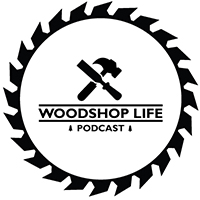Support us on Patreon: https://www.patreon.com/woodshoplife
Guy
1) Gentlemen-
Enjoying, as always, the podcast. Especially with the recent addition of my questions, and your informative, insightful, and obviously thoroughly researched and considered thoughts on my quandaries.
Onto my current woodworking-related predicament. I find myself both lacking a proper workbench, and having a surplus of black locust and white oak from my aforementioned shed project. My current workbench is a tall (40″) dining room table- when it served as such, it came as set with stools, not chairs. From Bloomingdales. For $2600 f@CKING DOLLARS! IT’S MDF SCREWED TOGETHER! Who gets a tall dining room table as the only horizontal surface in a 400 square foot Manhattan apartment? My ex-wife. Because that makes sense and if it doesn’t you are in the bad boy corner. Word of advice to your listeners – if your fiancée insists on haircuts that cost more than a Woodpeckers router lift, don’t. Just don’t and run and make up an excuse, but don’t. Ever. 5 months of hard lessons right there.
But I digress.
I have enough black locust to make a 26″ x 78″ top at about 3.5″ thick. My lumber dimensions range (rough, not nominal) from 4x4s to 2×10’s. The only bench top dimension limited by the lumber is the thickness. I feel like I want a “girth-ier” bench. The legs are going to be 4×6 white oak with 2×6 stretchers and in the drawings the top looks out of proportion.
I’m a big feller (6’4″) and I generate a lot of force with my hand tool work. I don’t want to bring the base dimensions down to suit the current possible top thickness.
So do you think I should suck it up and go grab some more 2×6+ and get me a 6″ thick top?
The goal here is to get rid of all of this black locust – it’s not good for woodworking, it’s the best for outdoor building, but I want to get back to woodworking.
But my parents, who live nearby, need a cathouse. The kind for sheltering an outdoor animal, not housing prostitutes. So I could potentially use the excess to make that impervious to the elements, and make my mom happy. Because apparently Jeff told her his little bitty feet get cold on the stone patio, and my dad built what looks like a homeless encampment out of tarps and pallets as a temporary shelter.
But I digress.
Tell your listeners to look @figurawoodwork on instagram they can see what I am talking about. I’m going to send you a pic direct so you don’t have to dig around. Continue the superlative work, may your blades stay sharp, and your fences square. Tom
2)Hey,
Thanks so much for the podcast! I have a delta contractor saw 36-725T2. I’m very happy with the saw and it happens to line up with my work bench well. The one thing I’m struggling with is, I feel the table is a little tall. I need to really stain to look straight down on the blade to line up fine joiner cuts. Such as diver tails and tenons. I thought of lowering the saw but I like my bench height, and don’t have room for an outfeed table and a bench. Which height is more important? Scott
Huy
1) Hey fellas! Love the podcast and the wealth of info you share. I’m building a dining room table out of old growth fir. I know it’s a bit silly to use such a soft wood for such a high traffic piece, but the wood came from a 12×12 post that was holding up part of my childhood home.
I’ve inset some brass pins and tubes in a flowing pattern on the table top and plan to finish it with Osmo oil ebony stain for colour to contrast the brass, but I’m stuck on what to do for an impact resistant top coat. Have any of you used a foam roller to roll on epoxy and build a couple of coats up? Would an epoxy with high solids be more durable than other more ‘tried and true’ finishes? The table is being gifted to my brother in law and they have a veeeery active toddler, so dents are inevitable but I’d like to protect it as best I can without doing an epoxy pour-over. Apologies if this question has been asked as I’m only on Ep 22! Thank you from Vancouver, BC – Bruce
1) As I sit here coughing and assuring everyone it isn’t covid I just have lungs full of Sapele, I thought to myself… The woodshop life guys can maybe help me. I try my best to wear all my PPE but I often find myself choosing between lung protection and eye (and ultimately hand) protection. I have tried many different masks and
Eye protection but every time if I am wearing both the glasses fog up and I can’t see so I take off the mask. What do you all wear or have you used to overcome this. I have seen the full face mask with Ac blowers but I can’t spend 500 and need something economical
Will
2) Great podcast fellas, such a wealth of knowledge. My question is about Sherwin Williams Hi-Build Precat Lacquer (low gloss white). I’ve been spraying it thru my Fuji for a few years. I know SW can tint it but I have a big assortment of trans tint dye. Wondering if it works as well as SW tints. Thanks David Morton ,Central Kentucky
Sean
